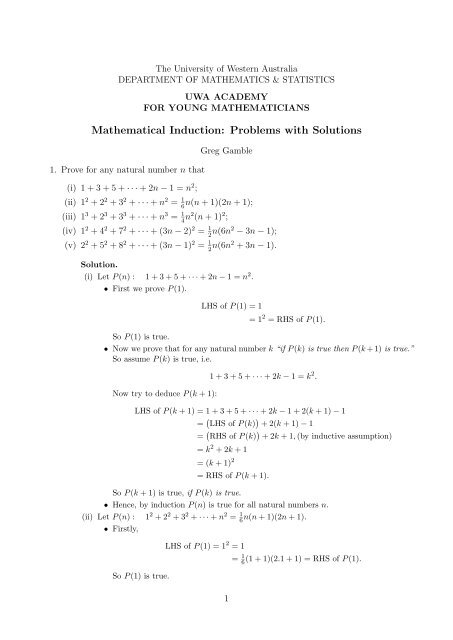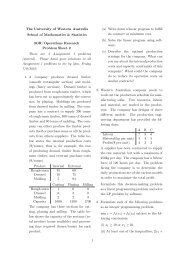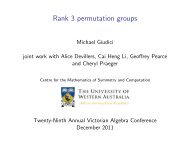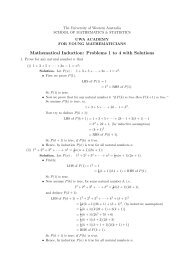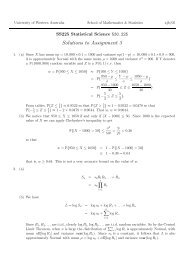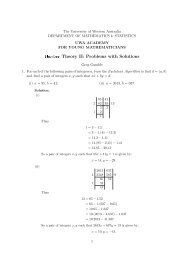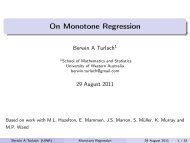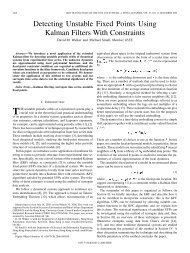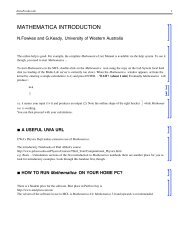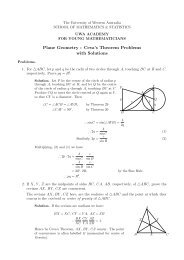Mathematical Induction: Problems with Solutions - The University of ...
Mathematical Induction: Problems with Solutions - The University of ...
Mathematical Induction: Problems with Solutions - The University of ...
Create successful ePaper yourself
Turn your PDF publications into a flip-book with our unique Google optimized e-Paper software.
<strong>The</strong> <strong>University</strong> <strong>of</strong> Western AustraliaDEPARTMENT OF MATHEMATICS & STATISTICSUWA ACADEMYFOR YOUNG MATHEMATICIANS<strong>Mathematical</strong> <strong>Induction</strong>: <strong>Problems</strong> <strong>with</strong> <strong>Solutions</strong>1. Prove for any natural number n that(i) 1 + 3 + 5 + · · · + 2n − 1 = n 2 ;Greg Gamble(ii) 1 2 + 2 2 + 3 2 + · · · + n 2 = 1 n(n + 1)(2n + 1);6(iii) 1 3 + 2 3 + 3 3 + · · · + n 3 = 1 4 n2 (n + 1) 2 ;(iv) 1 2 + 4 2 + 7 2 + · · · + (3n − 2) 2 = 1 2 n(6n2 − 3n − 1);(v) 2 2 + 5 2 + 8 2 + · · · + (3n − 1) 2 = 1 2 n(6n2 + 3n − 1).Solution.(i) Let P (n) : 1 + 3 + 5 + · · · + 2n − 1 = n 2 .• First we prove P (1).LHS <strong>of</strong> P (1) = 1= 1 2 = RHS <strong>of</strong> P (1).So P (1) is true.• Now we prove that for any natural number k “if P (k) is true then P (k + 1) is true.”So assume P (k) is true, i.e.Now try to deduce P (k + 1):1 + 3 + 5 + · · · + 2k − 1 = k 2 .LHS <strong>of</strong> P (k + 1) = 1 + 3 + 5 + · · · + 2k − 1 + 2(k + 1) − 1= ( LHS <strong>of</strong> P (k) ) + 2(k + 1) − 1= ( RHS <strong>of</strong> P (k) ) + 2k + 1, (by inductive assumption)= k 2 + 2k + 1= (k + 1) 2= RHS <strong>of</strong> P (k + 1).So P (k + 1) is true, if P (k) is true.• Hence, by induction P (n) is true for all natural numbers n.(ii) Let P (n) : 1 2 + 2 2 + 3 2 + · · · + n 2 = 1 6n(n + 1)(2n + 1).• Firstly,So P (1) is true.LHS <strong>of</strong> P (1) = 1 2 = 1= 1 6(1 + 1)(2.1 + 1) = RHS <strong>of</strong> P (1).1
• Now assume P (k) is true, for some natural number k, i.e.and deduce P (k + 1):1 2 + 2 2 + 3 2 + · · · + k 2 = 1 6k(k + 1)(2k + 1),LHS <strong>of</strong> P (k + 1) = 1 2 + 2 2 + 3 2 + · · · + k 2 + (k + 1) 2= ( LHS <strong>of</strong> P (k) ) + (k + 1) 2= ( RHS <strong>of</strong> P (k) ) + (k + 1) 2 , (by inductive assumption)= 1 6k(k + 1)(2k + 1) + (k + 1)2= 1 6 (k + 1)( k(2k + 1) + 6(k + 1) )= 1 6 (k + 1)(2k2 + 7k + 6)= 1 6(k + 1)(k + 2)(2k + 3)= 1 6 (k + 1)(k + 1 + 1)( 2(k + 1) + 1 )= RHS <strong>of</strong> P (k + 1).So P (k + 1) is true, if P (k) is true.• Hence, by induction P (n) is true for all natural numbers n.(iii) Let P (n) : 1 3 + 2 3 + 3 3 + · · · + n 3 = 1 4 n2 (n + 1) 2 .• Firstly,LHS <strong>of</strong> P (1) = 1 3 = 1= 1 4 .12 (1 + 1) 2 = RHS <strong>of</strong> P (1).So P (1) is true.• Now assume P (k) is true, for some natural number k, i.e.and deduce P (k + 1):1 3 + 2 3 + 3 3 + · · · + k 3 = 1 4 k2 (k + 1) 2 .LHS <strong>of</strong> P (k + 1) = 1 3 + 2 3 + 3 3 + · · · + k 3 + (k + 1) 3= ( LHS <strong>of</strong> P (k) ) + (k + 1) 3= ( RHS <strong>of</strong> P (k) ) + (k + 1) 3 , (by inductive assumption)= 1 4 k2 (k + 1) 2 + (k + 1) 3= 1 4 (k + 1)2( k 2 + 4(k + 1) )= 1 4 (k + 1)2 (k 2 + 4k + 4)= 1 4 (k + 1)2 (k + 2) 2= 1 4 (k + 1)2 (k + 1 + 1) 2= RHS <strong>of</strong> P (k + 1).So P (k + 1) is true, if P (k) is true.• Hence, by induction P (n) is true for all natural numbers n.(iv) Let P (n) : 1 2 + 4 2 + 7 2 + · · · + (3n − 2) 2 = 1 2 n(6n2 − 3n − 1).• Firstly,So P (1) is true.LHS <strong>of</strong> P (1) = 1 2 = 12= 1 2 .1(6.12 − 3.1 − 1) = RHS <strong>of</strong> P (1).
• Now assume P (k) is true, for some natural number k, i.e.and deduce P (k + 1):1 2 + 4 2 + 7 2 + · · · + (3k − 2) 2 = 1 2 k(6k2 − 3k − 1)LHS <strong>of</strong> P (k + 1) = 1 2 + 4 2 + 7 2 + · · · + (3k − 2) 2 + ( 3(k + 1) − 2 ) 2= ( LHS <strong>of</strong> P (k) ) + ( 3(k + 1) − 2 ) 2= ( RHS <strong>of</strong> P (k) ) + ( 3(k + 1) − 2 ) 2 , (by inductive assumption)= 1 2 k(6k2 − 3k − 1) + 9k 2 + 6k + 1= 1 2 (6k3 − 3k 2 − k + 18k 2 + 12k + 2)= 1 2 (6k3 + 15k 2 + 11k + 2)= 1 2 (k + 1)(6k2 + 9k + 2)= 1 2 (k + 1)( 6(k + 1) 2 − 12k − 6 + 9k + 2 )= 1 2 (k + 1)( 6(k + 1) 2 − 3k − 4 )= 1 2 (k + 1)( 6(k + 1) 2 − 3(k + 1) − 1 )= RHS <strong>of</strong> P (k + 1).So P (k + 1) is true, if P (k) is true.• Hence, by induction P (n) is true for all natural numbers n.(v) Let P (n) : 2 2 + 5 2 + 8 2 + · · · + (3n − 1) 2 = 1 2 n(6n2 + 3n − 1).• Firstly,So P (1) is true.LHS <strong>of</strong> P (1) = 2 2 = 4= 1 2 .1(6.12 + 3.1 − 1) = RHS <strong>of</strong> P (1).• Now assume P (k) is true, for some natural number k, i.e.2 2 + 5 2 + 8 2 + · · · + (3k − 1) 2 = 1 2 k(6k2 + 3k − 1)and deduce P (k + 1). We could follow an approach similar to the previous exercise;instead, we will demonstrate another technique: that <strong>of</strong> expanding an expression in3
k in powers <strong>of</strong> k + 1 by replacing k by k + 1 − 1.LHS <strong>of</strong> P (k + 1) = 2 2 + 5 2 + 8 2 + · · · + (3k − 1) 2 + ( 3(k + 1) − 1 ) 2= ( LHS <strong>of</strong> P (k) ) + ( 3(k + 1) − 1 ) 2= ( RHS <strong>of</strong> P (k) ) + ( 3(k + 1) − 1 ) 2 , (by inductive assumption)= 1 2 k(6k2 + 3k − 1) + 9(k + 1) 2 − 6(k + 1) + 1= 1 2 k( 3k(2k + 1) − 1 ) + 9(k + 1) 2 − 6(k + 1) + 1= 1 2(3 k ( (k + 1) − 1 )( 2(k + 1) − 1 ) )− 1 + 9(k + 1) 2 − 6(k + 1) + 1= 1 2(3 k ( 2(k + 1) 2 − 3(k + 1) + 1 ) )− 1 + 9(k + 1) 2 − 6(k + 1) + 1= 2( 1 )((k + 1) − 1 6(k + 1) 2 − 9(k + 1) + 2 ) + 1 (2 18(k + 1) 2 − 12(k + 1) + 2 )((k + 1) ( 6(k + 1) 2 − 9(k + 1) + 2 )= 1 2= 1 2− ( 6(k + 1) 2 − 9(k + 1) + 2 )+ (k + 1) ( 18(k + 1) − 12 ) )+ 2((k + 1) ( 6(k + 1) 2 − 9(k + 1) + 2 )− (k + 1) ( 6(k + 1) − 9 ) − 2+ (k + 1) ( 18(k + 1) − 12 ) )+ 2= 1 2 (k + 1) (6(k + 1) 2 − 9(k + 1) + 2− 6(k + 1) + 9)−18(k + 1) − 12= 1 2 (k + 1)( 6(k + 1) 2 + 3(k + 1) − 1 )= RHS <strong>of</strong> P (k + 1).So P (k + 1) is true, if P (k) is true.• Hence, by induction P (n) is true for all natural numbers n.2. Prove that for any natural number n,2( √ n + 1 − 1) < 1 + 1 √2+ · · · + 1 √ n< 2 √ n.Solution. Let P (n) : 2( √ n + 1 − 1) < 1 + 1 √2+ · · · + 1 √ n< 2 √ n. Now P (n) should bethought <strong>of</strong> as two simultaneous inequalities, namely:where(M is mnemonic for “middle”.)LHS(n) < M(n) and M(n) < RHS(n),LHS(n) := 2( √ n + 1 − 1),M(n) := 1 + 1 √2+ · · · + 1 √ nandRHS(n) := 2 √ n.4
• Firstly,andLHS(1) = 2( √ 2 − 1) = 2(√ 2 − 1)( √ 2 + 1√2 + 1=So P (1) is true.M(1) = 1 < 2 = 2 √ 1 = RHS(1).• Now assume P (k) is true, for some natural number k, i.e.and deduce P (k + 1):M(k) > LHS(k) and M(k) < RHS(k),M(k + 1) = 1 + √ 1 + · · · + 1 1√ + √2 k k + 11= M(k) + √k + 11> LHS(k) + √ , (by inductive assumption)k + 1= 2( √ k + 1 − 1) +1√k + 1= 2( √ k + 2 − 1) − 2( √ k + 2 − √ k + 1) +2√ < 22 + 1 1 + 1 = 1 = M(1),1√k + 1= 2( √ k + 2 − 1) − 2(√ k + 2 − √ k + 1)( √ k + 2 + √ k + 1) 1√ √ + √k + 2 + k + 1 k + 1= 2( √ k + 2 − 1) −> 2( √ k + 2 − 1) −= 2( √ k + 2 − 1) −2√k + 2 +√k + 1+2√k + 1 +√k + 1+1√k + 11√k + 122 √ k + 1 + 1√ = 2( √ k + 2 − 1) = LHS(k + 1),k + 15
andM(k + 1) = 1 + √ 1 + · · · + 1 1√ + √2 k k + 1= M(k) +< RHS(k) += 2 √ k +1√k + 11√k + 1, (by inductive assumption)1√k + 1= 2 √ k + 1 − 2( √ k + 1 − √ k) +1√k + 1= 2 √ k + 1 − 2(√ k + 1 − √ k)( √ k + 1 + √ k) 1√ √ + √k + 1 + k k + 1= 2 √ k + 1 −< 2 √ k + 1 −= 2 √ k + 1 −2√k + 1 +√k+1√k + 12√k + 1 +√k + 1+1√k + 122 √ k + 1 + 1√ = 2 √ k + 1 = RHS(k + 1).k + 1i.e. LHS(k + 1) < M(k + 1) < RHS(k + 1).So P (k + 1) is true, if P (k) is true.• Hence, by induction P (n) is true for all natural numbers n.3. Prove 3 n > 2 n for all natural numbers n.Solution. Let P (n) : 3 n > 2 n .• Firstly,LHS <strong>of</strong> P (1) = 3 1 = 3> 2 = 2 1 = RHS <strong>of</strong> P (1).So P (1) is true.• Now assume P (k) is true, for some natural number k, i.e.and deduce P (k + 1):3 k > 2 kLHS <strong>of</strong> P (k + 1) = 3 k+1= 3 k .3> 2 k .3, (by inductive assumption)> 2 k .2= 2 k+1= RHS <strong>of</strong> P (k + 1).i.e. LHS <strong>of</strong> P (k + 1) > RHS <strong>of</strong> P (k + 1).So P (k + 1) is true, if P (k) is true.• Hence, by induction 3 n > 2 n for all natural numbers n.6
4. Prove Bernouilli’s Inequality which states:If x ≥ −1 then (1 + x) n ≥ 1 + nx for all natural numbers n.Solution. Let P (n) : (1 + x) n ≥ 1 + nx, if x ≥ −1.• Firstly,LHS <strong>of</strong> P (1) = (1 + x) 1 = 1 + x= 1 + 1.x = RHS <strong>of</strong> P (1).So P (1) is true.• Now assume P (k) is true, for some natural number k, i.e.and deduce P (k + 1):LHS <strong>of</strong> P (k + 1) = (1 + x) k+1= (1 + x) k .(1 + x)(1 + x) k ≥ 1 + kx, if x ≥ −1= ( LHS <strong>of</strong> P (k) ) .(1 + x)≥ ( RHS <strong>of</strong> P (k) ) .(1 + x), (by inductive assumption. . . 1 + x ≥ 0 since x ≥ −1)= (1 + kx)(1 + x)= 1 + (k + 1)x + kx 2≥ 1 + (k + 1)x, (since k > 0, x 2 ≥ 0, so that kx 2 ≥ 0)= RHS <strong>of</strong> P (k + 1).So P (k + 1) is true, if P (k) is true.• Hence, by induction P (n) is true for all natural numbers n.5. Prove that for any natural number n ≥ 2,( 1 )( 1 ) ( 1 ) 21 − √2 1 − √3 · · · 1 − √n
• Firstly,So P (2) is true.LHS <strong>of</strong> P (2) = 1 − √ 1√2 − 1= √2 2= (√ 2 − 1)( √ 2 + 1)√2(√2 + 1)1=2 + √ 2< 1 2 = 2 = RHS <strong>of</strong> P (2).22 • Now assume P (k) is true, for some natural number k ≥ 2, i.e.and deduce P (k + 1):(1 −1 √2)(1 −1 √3)· · ·(1 −1 √k)
6. Prove that for any natural number n,12 · 34 · 56 · · · 2n − 1 ≤2nSolution. Let P (n) :• Firstly,12 · 34 · 56 · · · 2n − 1 ≤2n1√ 3n + 1.1√ 3n + 1.LHS <strong>of</strong> P (1) = 1 2 = √ 141= √ = RHS <strong>of</strong> P (1).3.1 + 1So P (1) is true.• Now assume P (k) is true, for some natural number k, i.e.and deduce P (k + 1):12 · 34 · 56 · · · 2k − 1 ≤2k1√3k + 1LHS <strong>of</strong> P (k + 1) = 1 2 · 34 · 56 · · · 2k − 1 2(k + 1) − 1·2k 2(k + 1)= ( LHS <strong>of</strong> P (k) ) · 2k + 12k + 2≤ ( RHS <strong>of</strong> P (k) ) · 2k + 1 , (by inductive assumption)====1√3k + 1 ·1√3k + 1 ·1√3k + 1 ·11 + 12k+112k + 2√(1 + 12k+1 )21√1 + 22k+1 + 1(2k+1) 21√3k + 1 + 2(3k+1)2k+1+ 3k+1(2k+1) 21< √3k + 1 + 6k+22k+1 + 2k+1(2k+1) 21= √3k + 1 + 6k+2+12k+11= √3k + 1 + 3=1√3(k + 1) + 1= RHS <strong>of</strong> P (k + 1).i.e. LHS <strong>of</strong> P (k + 1) < RHS <strong>of</strong> P (k + 1).So P (k + 1) is true, if P (k) is true.• Hence, by induction P (n) is true for all natural numbers n.9
7. Prove that 7 2n − 48n − 1 is divisible by 2304 for every natural number n.Solution. Let P (n) : 2304 f(n) where f(n) = 7 2n − 48n − 1.• Firstly, f(1) = 7 2.1 − 48.1 − 1 = 0 and 2304 0. So P (1) is true.• Now assume P (k) is true, for some natural number k, i.e.We now deduce P (k + 1).f(k + 1) = 7 2(k+1) − 48(k + 1) − 1= 7 2k .7 2 − 48(k + 1) − 12304 f(k).= (7 2k − 48k − 1).49 + (48k + 1).49 − 48(k + 1) − 1= 49.f(k) + (48k + 1).49 − 48(k + 1) − 1= 49.f(k) + (49 − 1).48k + 49 − 48 − 1= 49.f(k) + 2304k≡ 0(mod 2304), since 2304 f(k) by the inductive assumption.So P (k + 1) is true, if P (k) is true.• Hence, by induction P (n) is true for all natural numbers n.8. For every natural number n, show thatis a natural number.In fact, u n is the nth Fibonacci number.u n = (1 + √ 5) n − (1 − √ 5) n2 n . √ 5Solution. Before we apply induction we will find the following helpful. Observe that, forany numbers a, b and natural number n,a n+1 − b n+1 = (a + b)(a n − b n ) − ab(a n−1 − b n−1 ).Let α = 1 + √ 5 and β = 1 − √ 5. <strong>The</strong>nα + β = 2Also u n can be expressed more compactly asαβ = 1 − 5 = −4.u n = αn − β n2 n . √ 5 .Now we are ready to apply induction. We shall employ a variant <strong>of</strong> the usual induction. Inladder terminology, we show:• we can get onto the first two rungs; and that• if we can get onto the (k − 1)st and kth rungs then we can get onto the (k + 1)st rung.(At least, this is the general idea! . . . we don’t quite prove we can get onto the first rung, butwe do the next best thing! . . . and consequently we need to modify our inductive assumptionslightly as well!)Let P (n) : u n ∈ N where u n := αn − β n2 n . √ 5 .10
• Firstly,u 0 = (1 + √ 5) 0 − (1 − √ 5) 02 0 . √ 5u 1 = (1 + √ 5) 1 − (1 − √ 5) 12 1 . √ 5= 1 − 1 √5= 0 ∈ N ∪ {0}= 2√ 52 √ 5 = 1 ∈ N.• Now assume that for some natural number k,We now deduce u k+1 ∈ N.u k+1 = αk+1 − β k+12 k+1 . √ 5u k−1 ∈ N ∪ {0}, andu k ∈ N.= (α + β)(αk − β k ) − αβ(α k−1 − β k−1 )2 k+1 . √ 5= 2(αk − β k ) + 4(α k−1 − β k−1 )2 k+1 . √ 5= αk − β k2 k . √ 5 + αk−1 − β k−12 k−1 . √ 5= u k + u k−1 .Now u k , u k−1 are nonnegative integers (by our inductive assumption); so their sum isagain a nonnegative integer. Also, u k , u k−1 are not both zero (since we have assumedu k ∈ N); so their sum is a positive integer. Hence,u k+1 ∈ N, if u k−1 ∈ N ∪ {0} and u k ∈ N.• Hence, by induction u n ∈ N for all natural numbers n . . . and u 0 = 0.11


